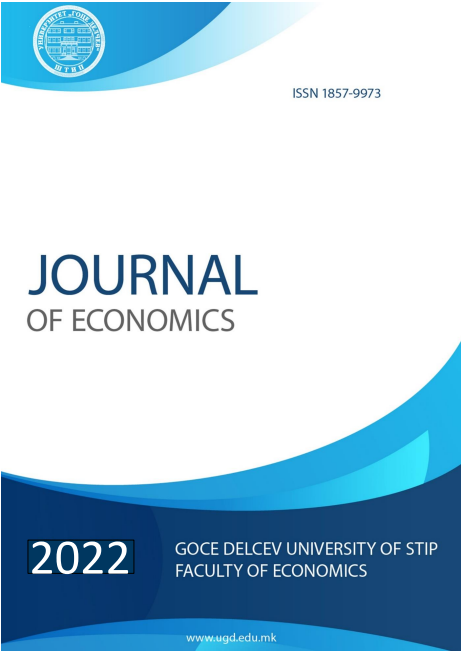How humanities can tackle with the consumption and greenhouse effect: through the prism of green logistics
Abstract
Sustainable development is a complex and global problem. Poverty, inequality, opacity, drought, floods, green house effects are just a few pieces of the puzzle called a real-world ecosystem. One such piece of the multitude of global problems concerns on the transport and logistics problems in urban centers and the pronounced need for green logistics. Following modern technological trends and the need for long-term sustainable development and environmental protection, especially in urban areas, as a growing and unstoppable phenomenon caused by global technological progress, possible promising alternatives, research and solutions are focused on the concept of green infrastructure and green logistics. The concept of Green Logistics occupies an important place in optimizing the transport sector, reducing traffic congestion and reducing emissions from vehicles. The concept of Green Logistics is primarily focused on issues related to environmental protection, such as environmental pollution and emissions caused by non-standard and insufficiently professionally arranged logistics processes and the use of old and environmentally unsuitable transport technology. Green Logistics is a model that is planned, organized and implemented through an environmentally friendly and often socially friendly dimension, in addition to the economically functional one. Covers all entities, legislation, activities and participants in order to minimize the environmental impact of transport activities. The goal is to create sustainable value for the company using a stable balance of economic and environmental efficiency. To meet strictly defined environmental goals, green logistic includes all activities of the forward and reverse flows of products, information and services between the point of origin and the point of consumption. It is the aim to create a sustainable company value using a balance of economic and environmental efficiency.
Downloads
References
2. Christianaid: The rich, the poor and the future of the earth: equity in a constrained world. April 2012. p.25. https://www.christianaid.org.uk/sites/default/files/2017-08/rich-poor-future-earth-equity-constrained-world-april-2012_0.pdf
3. Christianaid: The rich, the poor and the future of the earth: equity in a constrained world. April 2012. p.2. https://www.christianaid.org.uk/sites/default/files/2017-08/rich-poor-future-earth-equity-constrained-world-april-2012_0.pdf
4. Riedy C.(2013). The Social practices of Change Agency in the Context of Community Energy Use. People and the Planet 2013 Conference Proceedings. Transforming the Future, RMIT University, Melbourne, Australia, 2-4 July.p.1.
5. Buren V.N. et all. (2016). Towards a circular economy: the role of Dutch logistics industries and governments. Sustainability 2016, 8, 647; p.1. doi:10.3390/su8070647
6. Carne J. Ronald, 2016. Green infrastructure and green infrastructure planning: a review of concepts and practices with particular reference to Berlin, Germany. p.i
7. McDonald, L., W. Allen, M. Benedict, & K. O'Connor, 2005. Green Infrastructure Plan Evaluation Frameworks, Journal of ConservationPlanning1(1):12-43.
8. Williamson, K.S. Growing with Green Infrastructure; Heritage Conservancy: Doylestown, PA, USA, 2003.
9. EPA: Green infrastructure: What is green infrastructure? https://www.epa.gov/green-infrastructure/what-green-infrastructure [accessed 22.03.2021]
10. WG on a Green Infrastructure Strategy for the EU. Task 1. Scope and objectives of Green Infrastructure in the EU. 2011. p. 2.
11. Rodrigue J.P., Slack B., Comtois C. (2001): “The Handbook of Logistics and Supply-Chain Management”, Handbooks in Transport #2, London: Pergamon/Elsevier. p.1
12. Saroha R. (2014): Green Logistics & its Significance in Modern Day Systems. International Review of Applied Engineering Research. Volume 4, Number 1 (2014), pp. 89-92
13. Gadziński J.: The Impact of Local Transport Systems on Green Infrastructure – Policy Versus Reality. The Case of Poznan, Poland. Article in Urbani Izziv. November 2015 (special issue) DOI: 10.5379/urbani-izziv-en-2015.p.S65. 14. Rogers, D. S., & Tibben-Lembke, R. S. (1998). Going backwards: Reverse logistics trends and practices. Reno, NV: Reverse Logistics Executive Council.p.102-103.
15. Blumberg F.D. (2005): Introduction to Management of Reverse logistics and Closed Loop Supply Chain Processes. Boca Raton London New York Washington, D.C.2005. 16. Rogers, D. S., & Tibben-Lembke, R. S. (1998). Going backwards: Reverse logistics trends and practices. Reno, NV: Reverse Logistics Executive Council.p.102-103.
17. Brito M. P., Dekker R. : Reverse Logistics – a framework. Erasmus University Rotterdam. 2002 Econometric Institute Report EI 2002-38. p.1.
18. Büyüközkan, G. & Vardaroğlu, Z. (2008). Yeşil tedarik zinciri yönetimi. Lojistik Dergisi, 8, 66-73.
19. Beškovnik B., Jakomin L.: Challenges of Green Logistics in Southeast Europe. Promet – Traffic&Transportation, Vol. 22, 2010, No. 2, 147-155
20. Eurostat (2019): Energy, transport and environment statistics. Luxembourg: Publications Office of the European Union, 2019. p.24.
21. Eurostat (2019): Energy, transport and environment statistics. Luxembourg: Publications Office of the European Union, 2019. p.24.
22. https://www.maritime-executive.com/article/transport-uses-25-percent-of-world-energy [accessed 23.03.2021]
23. https://www.odyssee-mure.eu/publications/efficiency-by-sector/overview/final-energy-consumption-by-sector.html [accessed 23.03.2021]
24. https://www.eea.europa.eu/data-and-maps/data/external/energy-statistics-supply-transformation-and-consumption
25. https://www.eea.europa.eu/data-and-maps/daviz/share-of-transport-ghg-emissions-2#tab-googlechartid_chart_1 [accessed 23.03.2021]
26. https://sustainabledevelopment.un.org/topics/sustainabletransport [accessed 23.03.2021]
27. https://www.eea.europa.eu/data-and-maps/indicators/transport-emissions-of-greenhouse-gases-7/assessment
28. IIED. Sustainable cities: the nexus between resilience and resource efficiency. International Institute for Environment and development. https://www.iied.org/sustainable-cities-nexus-between-resilience-resource-efficiency [accessed 23.03.2021]
29. UN Habitat: Urbanization and Development: Emerging Futures. World cities report, United Nations Settlement programme, 2016. p.5.
30. Eberhardt L.C.M, Birved M., Birgisdottir H. Building design and construction strategies for a circular economy. Architectural Engineering and Design Management, DOI: 10.1080/17452007.2020.1781588 https://www.tandfonline.com/doi/full/10.1080/17452007.2020.1781588 [accessed 23.03.2021] 31. Temjanovski, Riste (2019) The social marketing strategy and transport policy to improving the quality of life in urban area. In: 5th Internatonal Scientific Confernce Geobalcanica 2019, 13-14 June 2019, Sofia, Republic of Bulgaria.
32. WBCSD: 8Business cases for the circular economy. Geneva: WBCSD, p.3. https://docs.wbcsd.org/2017/07/8business_case_studies.pdf
33. https://www.eea.europa.eu/publications/transport-increasing-oil-consumption-and [accessed 23.03.2021]



